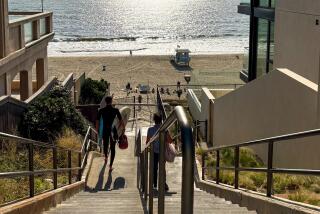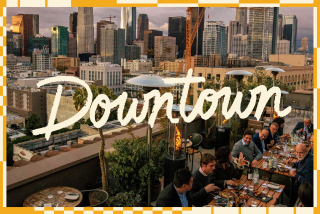Walking’s the Way to Experience Big D Frontier
DALLAS — “Start here and walk with Big D into the 1990s!”
That’s what Dallas is telling visitors as the city looks beyond Texas Sesquicentennial celebrations over the next few months to the coming years during which tourism will become increasingly vital to the city’s economy.
The word walk is more than a metaphor. With an estimated 93 million recreational walkers in the United States, walking has become the nation’s favorite fitness activity and a major factor in city sightseeing. Dallas is positioning itself in the forefront of all travel trends and wants its share of action from the walkers of the world.
Many Attractions
The “Dallas Downtown Walking Tour” brochure describes 66 inner-city destinations, from the spectacular overview atop Reunion Tower to the West End Historic District, the John F. Kennedy Memorial, Thanks-Giving Square and the live oak trees around the fountain in Ferris Plaza. Also included is the preview of the architecture-of-tomorrow emerging at the site of the Dallas Symphony Orchestra’s new home, which is targeted for a 1988 grand opening.
You can walk half an hour at a time or as long as 10 hours, depending on your stamina and how much you want to sightsee along the way.
The bottom line is: Dallas wants to use its comparative economic clout to grab a greater share of Texas’ tourism.
As in all of the Lone Star State, the economy of Dallas has been hit hard by the temporary surplus of oil on the world market and the consequent drop in state revenue.
However, with a more diversified economic base, Dallas is in a stronger position than most other destinations in Texas to promote its tourist attractions to the national and international markets.
In addition to more than 100 companies directly dependent on the oil industry, Dallas is the No. 1 center of insurance companies in the United States. More than 400 of the Fortune 500 list of largest U.S. industrial corporations have representation in the greater Dallas-Fort Worth area.
Dallas-based firms such as the nationwide HCB Construction Co., which has just completed the new Museum of Contemporary Art in Los Angeles, are helping to carry the Dallas story from coast to coast.
With tourism already its fifth-largest industry, Dallas is the No. 1 tourist city in Texas, the third-largest state in tourist traffic. The “Dallas Today” brochure describes its attractions in Spanish, French and German as well as English.
Dallas/Fort Worth Airport is served by more than 20 national and international airlines.
In addition to Crescent Court Hotel that opened in December as part of the Crescent complex of office towers and tri-level marketplace of shops and galleries, seven more hotels are scheduled to open within the next two years.
The Downtown Lunch Crowd
Let’s set the mood for a downtown walk by starting in Thanks-Giving Square at noon. This one-of-a-kind mid-town park is dedicated to meditation and giving thanks, “the habit of the grateful heart.” The Three Bells of Thanks-Giving peal out during the noon hour on weekdays and every half-hour on weekends and holidays.
The chapel in the Hall of World Thanksgiving offers an opportunity for quiet reflection and a personal expression of thanks. Special events and interfaith services are scheduled in the chapel garden. National flags symbolize the world community.
During the noon hour, office workers eat their brown-bag lunches while sunning on park benches.
A few moments’ walk east is the Majestic Theater, listed on the National Register of Historic Places and renovated as a theater for ballet, drama and music.
About six blocks north of Thanks-Giving Square is the Dallas Museum of Art and its outdoor sculpture garden. Three blocks south of the square is the home of the internationally famous Neiman-Marcus stores.
A leisurely 10-minute walk west, through modern high-rises, leads to the West End Historic District where warehouses built early in this century are being renovated into restaurants and night spots.
In the nearby Historical Plaza is the John Neely Bryan cabin on a bluff above the Trinity River where Dallas was born when he established his trading post there in 1841. During the next decade the Republic of Texas opened its central national road.
Close by, a group of visionary French settlers founded La Reunion, a Utopian settlement, in 1854. In the following years, Swiss and German settlers added to the international mix.
Within the Reunion complex today, the atrium lobby of the 1,000-room Hyatt Regency appears to be sheer walls of glass. And it is from the geodesic dome of Reunion Tower that you can get a perspective of the greater metropolitan area in which 3 million people live. Parks and suburban areas beckon the walker in every direction.
After descending from the tower in a glass-walled elevator, the footloose way leads to the 18,500-seat Reunion Arena sports and entertainment center, home of the National Basketball Assn.’s Mavericks, Dallas Sidekicks Soccer, the World Championship Tennis Finals and other events.
Here you are virtually next to the renovated Beaux-Arts architecture of Union Station, once the site of the wagon train terminal. Amtrak and buses now use the lower level. Restaurants are upstairs in the Grand Hall. The Visitor’s Center at the station will guide you on your way with maps and brochures.
Memories of Kennedy
Near the approach to the Reunion complex, President John F. Kennedy was shot on Nov. 22, 1963. The Kennedy Memorial cenotaph is across Main Street from the Bryan cabin, about 200 yards from where the President was shot. Two blocks west on Houston Street you can pause to look up at the sixth-floor window of what was then known as the Texas Schoolbook Depository, from which Lee Harvey Oswald is said to have looked down upon the President’s car.
One after another, symbols of the old and new Dallas show up along your path: The Old Red Courthouse with its gargoyles on the roof, the new Communications Center, the green space of Dealey Plaza named for the founder of the Dallas Morning News, the Old Brewery and the Old Spaghetti Warehouse renovations into restaurants and shops.
Also the New Arts Theater, Old City Park looking into the life and architecture of the 19th Century, the baroque eclecticism architecture of the elegantly restored Adolphus Hotel built by the Busch brewery family.
Two miles east of downtown a bus can drop you off to begin another walk in State Fair Park. The museums there have something for many interests: The Age of Steam Railway exhibit, Museum of Science and Technology, Museum of Natural History with an old-fashioned wooden roller coaster for the children.
The summer Shakespeare Festival is staged in the park band shell, the summer musicals and the Metropolitan Opera in its Music Hall.
The Cotton Bowl is in the park, and the park’s biggest event of the year will be bigger than ever this autumn--the State Fair of Texas, largest event of its kind in the nation.
The 100-year-old fair has been expanded to 31 days, from Sept. 26 to Oct. 26. A highlight of the fair will be the hit musical “Cats.” One of the biggest rodeos ever staged will be another attraction.
The Night Life
In the suburbs near Prestonwood, a new area of restaurants and night life is drawing visitors. The new “Dallas Dining Guide” at the Visitors and Convention Bureau has 18 pages of dining and after-dark action.
Lake Arlington and Bachman Lake are two of the lakes nearest to Dallas with walking trails around their shores, along with bicycling, boating, sailing, picnicking and fishing.
At Texas Stadium and Arlington Stadium the Dallas Cowboys of the National Football League and the Texas Rangers of American League West are two the most heavily promoted seasonal attractions for visitors.
About 200 city park tennis courts, half a dozen public golf courses and 20 stables for horseback-riding provide still other changes of pace for the footloose visitor.
We’ve enjoyed walking this time from our French chateau accommodations at the new Hotel Crescent Court near downtown into the winding, tree-lined paths along Turtle Creek.
The Crescent Trolley offers pickups and drop-offs at 29 Dallas landmark areas.
Dining temptations at the end of a walking day have been the Beau Nash Restaurant-as-Theater at our hotel, with eight chefs on center stage, and the restaurant in the elegant, restored Mansion on Turtle Creek, a 1925 Italian Renaissance-style building.
The visitors bureau “Weekends Guide” lists 36 pages of weekend packages and bargains in all price ranges. To honeymoon like a lord and lady for two weekend nights at Crescent Court is $350 this summer, including champagne, breakfast served in your room and sharing the European spa facilities.
For complete information in preparing for a visit to Big D, contact the Dallas Convention and Visitors Bureau, 1507 Pacific Ave., Dallas 75201; (214) 954-1480.)
More to Read
Sign up for The Wild
We’ll help you find the best places to hike, bike and run, as well as the perfect silent spots for meditation and yoga.
You may occasionally receive promotional content from the Los Angeles Times.






